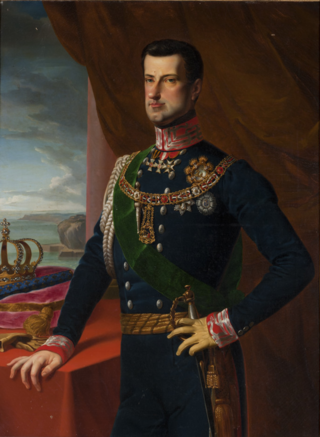
Charles Albert was the King of Sardinia and ruler of the Savoyard state from 27 April 1831 until his abdication in 1849. His name is bound up with the first Italian constitution, the Albertine Statute, and with the First Italian War of Independence (1848–1849).

Johann Josef Wenzel Anton Franz Karl, Graf Radetzky von Radetz was a Czech nobleman and Austrian field marshal. He served as chief of the general staff in the Habsburg monarchy during the later period of the Napoleonic Wars and proved instrumental in the allied victory as one of the primary architects of the Trachenburg Plan and the Leipzig Campaign. Afterwards, he embarked on military reforms of the Austrian army. His reputation was one of discipline and fairness; he was revered by his troops among whom he was known as Vater ('Father') Radetzky. He is best known for the victories at the Battles of Custoza and Novara during the First Italian War of Independence. Johann Strauss I's Radetzky March was commissioned to commemorate Radetzky's victories at the Battle of Custoza.

Massimo Taparelli, Marquess of Azeglio, commonly called Massimo d'Azeglio, was a Piedmontese-Italian statesman, novelist, and painter. He was Prime Minister of Sardinia for almost three years until his rival Camillo Benso, Count of Cavour succeeded him. D'Azeglio was a moderate liberal who hoped for a federal union between Italian states.
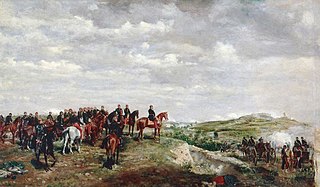
The Second Italian War of Independence, also called the Sardinian War, the Austro-Sardinian War, the Franco-Austrian War, or the Italian War of 1859, was fought by the Second French Empire and the Kingdom of Sardinia against the Austrian Empire in 1859 and played a crucial part in the process of Italian Unification.
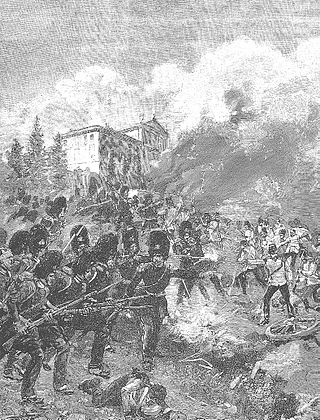
The First Battle of Custoza was fought on July 24 and 25, 1848, during the First Italian War of Independence between the armies of the Austrian Empire, commanded by Field Marshal Radetzky, and the Kingdom of Sardinia, led by King Charles Albert of Piedmont-Sardinia.

The Subalpine Republic was a short-lived republic that existed between 1800 and 1802 on the territory of Piedmont during its military rule by the French Consulate.

Novara is the capital city of the province of Novara in the Piedmont region in northwest Italy, to the west of Milan. With 101,916 inhabitants, it is the second most populous city in Piedmont after Turin. It is an important crossroads for commercial traffic along the routes from Milan to Turin and from Genoa to Switzerland. Novara lies between the streams Agogna and Terdoppio in northeastern Piedmont, 50 km (31 mi) from Milan and 95 km (59 mi) from Turin. It is only 15 km (9.3 mi) distant from the river Ticino, which marks the border with Lombardy region.

The Ten Days of Brescia was a revolt which broke out in the northern Italian city of that name, which lasted from 23 March to 1 April 1849.

SMS Novara was a sail frigate of the Austro-Hungarian Navy most noted for sailing the globe for the Novara Expedition of 1857–1859 and, later for carrying Archduke Maximilian and wife Carlota to Veracruz in May 1864 to become Emperor and Empress of Mexico.
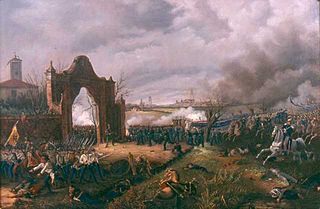
The First Italian War of Independence, part of the Italian Unification (Risorgimento), was fought by the Kingdom of Sardinia (1720–1861) (Piedmont) and Italian volunteers against the Austrian Empire and other conservative states from 23 March 1848 to 22 August 1849 in the Italian Peninsula.

The Battle of Goito was fought between the Piedmontese and the Austrian army on 30 May 1848, in the course of the First Italian War of Independence. The Piedmontese army won the battle, as the Austrians were unable to break through to relieve the siege of Peschiera and prevent its surrender which happened on the day before the battle.

The Skirmish of Pastrengo was fought between the Piedmontese and Austrian army on 30 April 1848, in the course of the First Italian War of Independence.

The Republic of San Marco or the Venetian Republic was an Italian revolutionary state which existed for 17 months in 1848–1849. Based on the Venetian Lagoon, it extended into most of Venetia, or the Terraferma territory of the Republic of Venice, suppressed 51 years earlier in the French Revolutionary Wars. After declaring independence from the Habsburg Austrian Empire, the republic later joined the Kingdom of Sardinia in an attempt, led by the latter, to unite northern Italy against foreign domination. But the First Italian War of Independence ended in the defeat of Sardinia, and Austrian forces reconquered the Republic of San Marco on 28 August 1849 following a long siege.

Bernhard Freiherr von Wüllerstorf-Urbair, also: von Wüllersdorf-Urbair or von Wüllerstorf und Urbair, was an Austrian vice admiral and, from 1865 to 1867, (k.k.) Austrian Imperial Minister of Trade. He was captain of the frigate SMS Novara, including during the world voyage (Novara-Expedition) in 1857-1859.
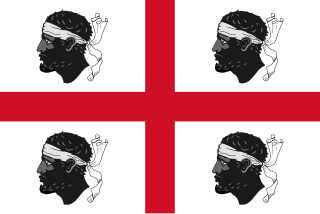
The Kingdom of Sardinia, also referred to as the Kingdom ofSardinia-Piedmont or Piedmont-Sardinia as a composite state during the Savoyard period, was a country in Southern Europe from the late 13th until the mid-19th century.

The Piedmontese Republic was a revolutionary, provisional and internationally unrecognized government established in Turin between 1798 and 1799 on the territory of Piedmont during its military rule by the French First Republic.

The Regiment "Nizza Cavalleria" (1st) is a cavalry unit of the Italian Army based in Bellinzago Novarese in Piedmont. The regiment is the reconnaissance unit of the Alpine Brigade "Taurinense".

The Battle of Volta Mantovana of 1848 was an engagement during the First Italian War of Independence fought throughout Volta Mantovana on 26 and 27 July 1848 between the Second Austrian army corps of General Konstantin D'Aspré and the 3d Piedmontese division of general Ettore De Sonnaz. It resulted in a decisive Austrian victory.
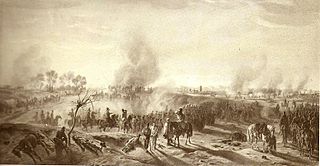
The Battle of Mortara was a battle between 19,000 Austrian and 26,000 Italian forces on 21 March 1849.
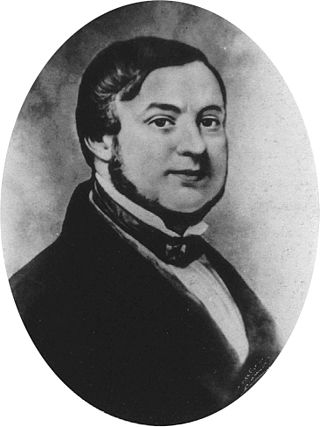
Pier Dionigi Pinelli was an Italian politician.




















